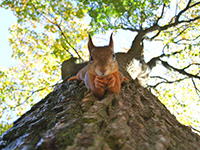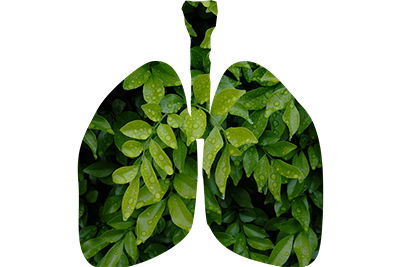Trees are beneficial in so many ways. We’ve discussed using trees as windbreaks, planting ornamental trees for visual embellishments, and saving money on energy bills by using the shade that trees provide to your advantage. In addition to all the great things trees do for us, they do even more for nature and wildlife. From food and shelter to cleaning our air and storing carbon, trees and tree service in Monmouth County support nature and wildlife.
Birds, Squirrels, and Other Animals Appreciate Trees
 Providing a habitat is one of the top advantages of trees in nature. Birds, squirrels, and many other animals turn to trees to be their homes. Canopies of deciduous trees can help protect inhabitants from predators and escaping into a tree eliminates threats that can’t climb or fly. Plus, trees are a great place to raise young for many creatures.
Providing a habitat is one of the top advantages of trees in nature. Birds, squirrels, and many other animals turn to trees to be their homes. Canopies of deciduous trees can help protect inhabitants from predators and escaping into a tree eliminates threats that can’t climb or fly. Plus, trees are a great place to raise young for many creatures.
In addition to that, trees and shrubs supply the animals that enjoy them with food. Berries, seeds, fruits and nuts are the primary source of nutrition for many wildlife. Even leaves and flowers feed birds and other animals. Aside from trees themselves providing food, they are also home to many bugs and insects that are the main food supply of woodland creatures.
In order for the trees in your yard to continue to offer all these benefits, contact us for your tree service in Monmouth County.
Trees and Tree Service in Monmouth County Benefit the Earth
Healthy trees and their roots help aerate soil allowing more nutrients to be delivered to the soil and the living things planted in it. In addition to that, decaying leaves and tree bits increase the level of nutrients in the soil by creating natural compost. This improves soil biodiversity which directly improves the health of the lawn and trees growing in that soil.
Sturdy root systems also help to prevent erosion. As soil gets washed away, the nutrients held within it goes away too. Soil also helps absorb rain and water reducing flooding and wash-out. By slowing the flow rate, erosion is greatly reduced. Without roots to hold on to the soil, it can get swept in bodies of water polluting it. To get the healthiest roots, make sure you provide your trees with professional tree service in Monmouth County.
Homeowners keep house plants for a variety of reasons, but one of them is because plants help clean the air. If small house plants can improve the indoor air quality of a home, consider the impact that trees have around the world. This is why maintaining healthy trees worldwide are so crucial. Removing pollutants like carbon dioxide is essential to sustaining life on earth. But trees don’t just filter out toxins. Through photosynthesis, they also produce oxygen by converting carbon dioxide in the environment.
Our Trees Service in Monmouth County Supports the Environment
 As trees take in carbon dioxide and expel oxygen, they store the extra carbon in their trunks. The larger the tree, the more carbon it can store. This is why taking care of trees is so important. We need large, mature, healthy trees to treat our air and provide so many other benefits.
As trees take in carbon dioxide and expel oxygen, they store the extra carbon in their trunks. The larger the tree, the more carbon it can store. This is why taking care of trees is so important. We need large, mature, healthy trees to treat our air and provide so many other benefits.
By trimming certain branches off of a tree, the weight of the top of the tree is changed. If you remove too many limbs on one side, the tree will become too heavy on one side and is likely to uproot. This is why professional tree service in Monmouth County by a licensed tree company is so essential. Trees provide so many benefits. The catch is that they can only do that if taken care of properly. Contact us today if you have trees in your yard that could use a little TLC.
Planting a new tree can be such an exciting time. In the best cases, this new tree will provide decades of benefits. With improper care, however, saplings rarely last more than a year or two. This month we’ll talk about the differences between new and mature trees, when to plant trees, and how to care for them once you do. If you ever have any questions or need tree service in Toms River, Waretown, Manahawkin or any town in Ocean and Monmouth counties, contact us anytime.
Saplings Versus Mature Trees
Aside from size, there are many differences between a sapling and a tall, mature tree. For one, size isn’t all about trunk and canopy height. It also has a lot to do with the root system. Young trees have a smaller root system which grows and spreads as the tree ages. In nature, new trees are able to use the assistance of other trees to obtain nutrients and resources because their roots do not extend very far to find water and other necessities. However, if you are planting a new tree on your property, it generally stands alone. Without the support system of other trees, saplings often struggle. The first few years of a tree’s life might be the most important. Mature trees rarely need regular intervention. Rather, they usually only need tree service if there is damage or pests. Saplings on the other hand, need steady attention.
When to Plant Trees
Most shrubs, bushes, and trees do best when planted during their non-growing season. This means early spring and fall are the best times of year to plant a new tree. In the spring, the dormant season is any time prior to budding. For deciduous trees, after the leaves have fallen in the autumn is the best time to plant. Planting in the fall gives the tree a full season of growth before the heat and other stresses of summer. During this “dormant” season, the tree doesn’t actually shut down completely, but rather, drastically slow their growth. This allows young trees to focus on what they need to which is growing their root system.
How to Care for Newly Planted Trees

Caring for saplings is very different than caring for aged trees. It can be tempting to fertilize early and often for any new plant. For trees, however, fertilizing saplings is not recommended and, in fact, can be very harmful and stunt their growth. The first two years of a tree’s life should be focused on building strong roots. As so much of the tree’s energy needs to go to root building, it is unable to expend a lot of energy on growing leaves and branches. Giving fertilizer to young trees forces the tree to expend too much energy on canopy growth. Funneling this energy towards top-growth too soon takes energy away from root growth. Although you may not see the results for a few years, weak roots can kill trees. If your sapling seems to be struggling, give us a call before you reach for the fertilizer!
Watering a new tree is as important as it is for any new plant. When it is first planted, daily watering is recommended. As the weeks pass, you can reduce your watering to every few days to once a week. If you planted during a rainy season, precipitation may be enough water for the tree to survive. Be careful not to overwater as that can kill a tree just as fast as not giving it enough water.
The Proper Way to Use Mulch Around a Tree
There is one correct way and many incorrect ways to apply mulch around the base of your trees. No matter the age, you never want mulch to touch the bark or trunk of a tree. There should be a few inches to a foot of space between a trunk and your mulch.
One of the most dangerous mulching techniques is called volcano mulching. This is harmful to a tree for a few reasons. One, because mulch is so insulating, using too much mulch too close to a tree can actually inhibit the uptake of resources rather than preserve them. Two, allowing the bark and trunk of a tree to get and remain wet can lead to pest infestations, diseases, and cracked, unhealthy bark. Bark is a trees way of defending itself against many things and having a chink in that armor is never a good thing. Lastly, volcano mulching can cause roots to grow in a circle around the tree rather than spreading out into the soil. Weak roots mean weak trees.
Once Your Tree is Established, We Take Over Your Tree Service in Toms River
After a few years, most trees can be termed established. Once a tree can sustain it’s growth on it’s own, we can take over from there. Mature trees planted in yards often need care every few years. Whether that tree service in Toms River is pruning or trimming or diagnosing diseases or pests, we can help. For all the best advice on how to select, plant, and care for a new tree in your yard, contact us today!
